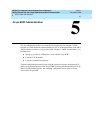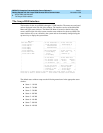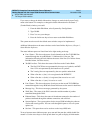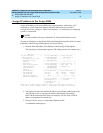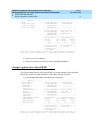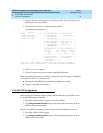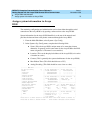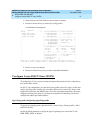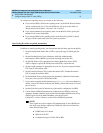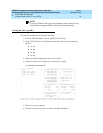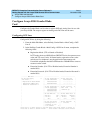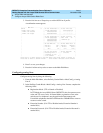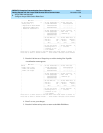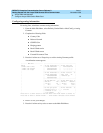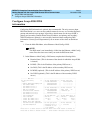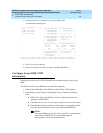
DEFINITY Enterprise Communication Server Release 9
Getting Started with the Avaya R300 Remote Office Communicator
Issue 1
November 2000
Avaya R300 Administration
75Configure Avaya R300 T1 lines (PSTN)
5
To configure the signaling mode you selected, do the following:
■ If you selected ISDN_NFAS as the signaling mode, set the NFAS ID Num field to
specify a number from 0 to 31 for each NFAS line. You must set this field to a
unique number. The default is 1 for line 1 and 2 for line 2.
■ If you selected Inband as the signaling mode, set the Rob Ctl field to specify the
robbed-bit call-control mechanism.
■ If you selected ISDN as the signaling mode, set the Switch Type field to specify
the type of WAN switch used at the line’s point-of-presence.
Specifying the other required parameters
In addition to setting signaling mode, you must perform the following steps for the profile:
1. Set the Framing Mode field to D4 or ESF to specify the type of framing the line
uses.
2. Set the Encoding field to None (identical to AMI, but without density
enforcement), AMI, or B8ZS to specify the encoding used on this line.
3. Set the FDL field to N/A (appropriate for Framing Mode=D4), None, AT&T,
ANSI, or Sprint to specify the Facility Data Link (FDL) used on the line.
4. Set the Length parameter as appropriate for your site. If you are using the internal
CSU, keep it at the default value.
5. Set the Front End field to CSU to enable the internal CSU. Disable the internal
CSU by setting Front End to DSX.
6. Set the Buildout field to specify proper line attenuation. Obtain this information
from your service provider. The default is 0dB.
7. If you cannot accept the default channel usage of switched for every channel on
the line, set the Ch N field to Switched (the default), Nailed (dedicated), or Unused
(not in service).
8. Set the Ch24 field to the D Channel only if the trunk is configured to be ISDN.
9. Use the Collect DNIS/ANI parameter to enable the Avaya R300 to collect the
Automatic Number Identifier (ANI) and the Dialed Number Identification String
(DNIS) signals. From the Main Edit Menu, select Net/T1>Line
Config>10-1**>Line 1 Menu to use the Collect DNIS/ANI parameter.
NOTE:
These signals are used to support ANI authentication of Avaya R300 users
and single-stage dialing, respectively. DNIS and ANI can be collected for
three network signal types:
■ DTMF tones in T1 inband
■ MF tones in E1 R2
■ D channel messages in T1/E1 PRI or BRI



